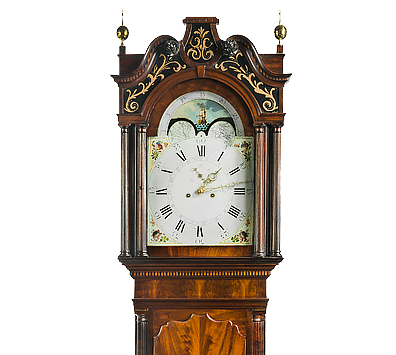Ingraham Clock History
The master behind Ingraham Clocks was Elias Ingraham (1805-1885). Elias, who lived to the advanced age of 80, was born in Marlborough, Connecticut. He came to Bristol in 1828 to work for George Mitchell building clock cases. In 1830, Elias Ingraham, now a noted clock casemaker, began working for Chauncey and Lawson C. Ives. He made over five thousand clock cases for them over the next three years. As a group, Ingraham clocks, and especially the clocks made under a label bearing the Ingraham name up until 1885, refer to clocks made by several different companies. The firm of Brewster and Ingrahams Clock Company was formed in 1844 and operated until July 24, 1852.
During this time Elias designed the Gothic clock case, with four columns. The E. and A. Ingrahams Company was then started and ran from 1852 to 1856; and then Elias Ingraham and Company from 1857 to 1860. Then from 1861 to 1880 the name E. Ingraham & Company was used. From 1881 to 1884, the company was known as The E. Ingraham & Company. Finally in 1885 it was incorporated as The E. Ingraham Company. This well-documented history and short time periods for each company make it easy to date the early Ingraham clocks based upon the label.
Clock Cases
While we tend to think of patents in clockmaking as applying to the mechanical aspects of clock works, Elias Ingraham contributed to the industry by focusing on clock cases. He received a total of 17 patents between 1857 and 1873 pertaining to clock cases. Ingraham patented the elegant and graceful figure 8 door design that was a hallmark of Ingraham clocks.
Elias Ingraham remained as the head of his company until his death in 1885 when his son Edward Ingraham took his place. Edward Ingraham followed in his father’s footsteps and received a patent pertaining to clock cases in 1884.
Edward Ingraham invented the process for applying black enamel paint to clock cases, where enamel paint gives a smooth and shiny finish when dry. The black mantel clocks that gained great popularity in the late 1800’s and early 1900’s were manufactured by not only the Ingraham company but also other leading American clockmakers using Edward Ingraham’s patented technique. There were more than 200 styles of Ingraham black mantel clocks made up until the 1920’s when they were in style.
The Twentieth Century
Like other clock manufacturers of the era, the Ingraham Company introduced pocket watches to their inventory in 1913, eight-day lever-movement clocks in 1915, and electric clocks in the 1930’s. They started wrist watches in 1932.
Watches were made until the 1960’s. Also like other clock manufacturers, the Ingraham Company closed clock production during World War II to instead support the war effort by making fuses and timers. However, some clocks were made during the war in the plant they opened in Toronto, Canada in 1941. In 1954 they opened a plant in Elizabethtown, Kentucky and in 1959 in Laurinburg, North Carolina.
After World War II the Ingraham Company abandoned the old pendulum clocks in favor electric clocks and alarm clocks . The company also maintained the production of watches, fuses and timers. The Ingraham Company was the final name change in 1958. In 1967 the old company was sold to McGraw-Edison which continues to make electric clocks using the Ingraham trademark.

Ship Your Clock for Expert Repairs!
Expert Shipping Instructions!

Grandfather Clock Service Calls
We make Grandfather Clock service calls!

Contact Us
Feel free to contact us any time at (215) 862-2415.

Further Questions?
We'd like to hear from you!
People Say




